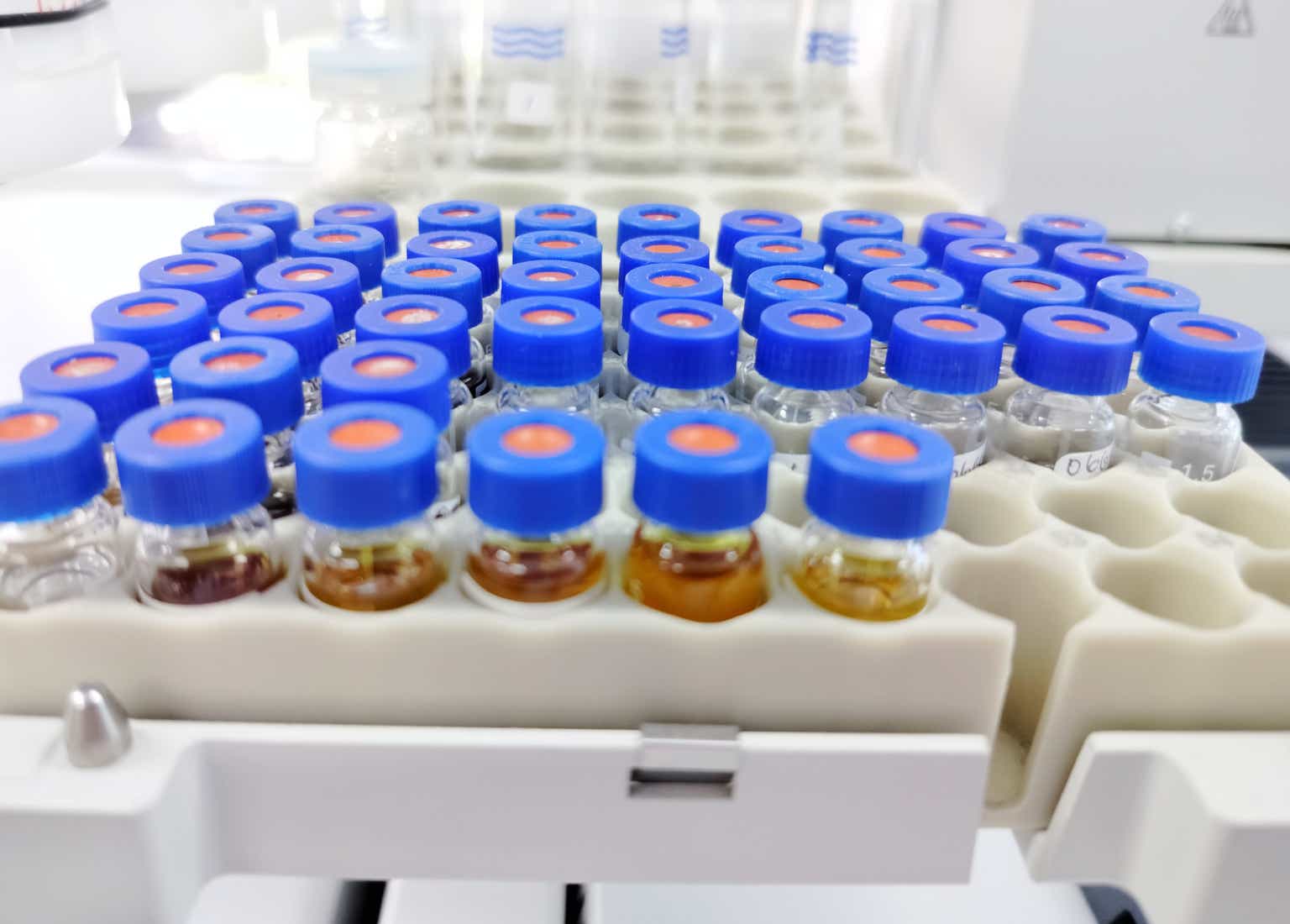Heri Harmono/iStock via Getty Images
CRISPR Therapeutics AG (NASDAQ:CRSP) is a good speculative biotech play to look into. The reason why I say that is because it, along with its partner Vertex Pharmaceuticals Incorporated (VRTX), submitted a Biologics Licensing Applications [BLA] to the FDA of exa-cel for the treatment of patients with transfusion dependent beta thalassemia [TDT] and severe sickle cell disease [SCD]. In addition, it has already also been able to submit exa-cel for review for the very same patient populations in the European territories as well.
While the potential to receive FDA approval and even European approval of exa-cel for these indications will be a huge catalyst, I believe that there is also potential in its ongoing immuno-oncology program. Why I do believe that this is the case? That’s because it already came to an agreement with the FDA to launch a potentially pivotal single-arm registrational trial using CTX-110 for the treatment of heavily pre-treated patients with large B-cell Lymphomas [LBCL]. This trial continues to enroll patients and what makes this program ideal is that if it successful, then CRISPR will be able to file for Accelerated Approval of CTX-110 for the treatment of patients with LBCL.
Not only that, but this biotech is prepared to reduce risk for investors. By that, I mean it has already started toward developing another allogeneic Chimeric Antigen Receptor [CAR-T] by the name of CTX-112. In essence, this is similar to CTX-110 but it incorporates additional edits to genes encoding Regnase-1 and TGFBRII. The reason for advancing CTX-110 into a phase 2 single-arm registrational study is because of proof of concept results, which were released back in December of 2022 at the American Society of Hematology [ASH] Medical Conference.
CTX-110 Moves Forward Towards Phase 2 Single-Arm Study
As I stated above, while the BLA filing of exa-cel is great, there is much more to CRISPR Therapeutics AG than that. It has already advanced CTX-110 for the treatment of patients with Large B-cell Lymphoma [LBCL] into a single-arm phase 2 registrational study. It continues to enroll patients into the study currently.
The reason why I believe this is an important part of its pipeline is because if the primary endpoint of this study is met, then it might be possible to file for regulatory approval of CTX-110 for the treatment of patients with LBCL. Why is that? That’s because the FDA and CRISPR have come to an agreement that it is possible to turn this single-arm study into a registrational one. Of course, such an event won’t happen until the final results are communicated with the FDA, but the fact that it is possible for CRISPR Therapeutics AG to file for a regulatory application only on the basis of this single-arm study is quite remarkable in itself.
The reason for advancing the use of CTX-110 for the treatment of patients LBCL into a phase 2 single-arm registrational trial is because CRISPR was able to achieve positive results from the phase 1 CARBON study. This was an early-stage study which tested out several dose levels of this CAR-T for the treatment of relapsed/refractory B-cell malignancies. Not only was proof of concept established in using CTX-100 for the treatment of this patient population, but it was also noted on what dose would be used to move forward towards the phase 2 single-arm study. It was stated that dose level 4 would be used along with standard lymphodepletion. There were two parts to this study, which were Part A and Part B. The following treatments for each part is as follows:
- Part A – single dose of CTX-110 following three days of standard lymphodepletion consisting of fludarabine (30mg/m2/day) and cyclophosphamide (500mg/m2/day). Patients received CTX110 at doses ranging from Dose Level [DL] 1 (30 million CAR+ T cells) to DL4 (600 million CAR+ T cells), with an option to re-dose CTX110 based on clinical benefit
- Part B – CTX110 at DL4 following standard lymphodepletion, as well as a consolidation dose of CTX110 at the same dose level between four and eight weeks after the initial dose for patients that demonstrate clinical benefit.
The primary endpoint tracked both safety [in terms of dose limiting toxicities] and overall response rate [ORR]. As you can see above, Part B of the study was crucial in that it tested CTX-110 at dose level 4, which is what is being used for the ongoing phase 2 single-arm trial. It was noted that Part A of the phase 1 CARBON study went well in that it was shown that patients who received CTX-110 at DL≥3 [27 patients] resulted in an ORR of 67% and CR rate of 41%. This is pretty good in my eyes, especially when you consider that about 47% of the patients recruited into this study had ≥3 prior lines of therapy. If this wasn’t encouraging enough, things got better with part B of the study in that several patients continued on with a complete response [CR] beyond 6 months. In addition to complete response being improved for an extended period of time, there was a conversion of patients moving from stable disease [SD]/partial response [PR] to ongoing CR after having received a 2nd dose.
Financials
According to the 10-Q SEC Filing, CRISPR Therapeutics AG had cash, cash equivalents and marketable securities of $1.88 billion as of March 31, 2023. It is important to note that an increase in cash of $21.1 million was obtained because of an upfront payment received from Vertex in connection with a non-exclusive license agreement. In addition, in August of 2019, in entered into a 2019 Sales Agreement with Jefferies and filed a prospectus supplement of $419.8 million in July of 2021. As of March 31, 2023, it issued and sold an aggregate of 1.1 million shares of common stock under a prospectus supplement at an average price of $168.79 per share for aggregate proceeds of $178.8 million.
CRISPR states in its 10-Q SEC filing that it believes it has enough cash on hand to fund its operations for at least the next 24 months. I believe that it is good on cash for now, but I believe this situation will change once it receives FDA and/or European approval of exa-cel for TDT and SCD. If it does achieve regulatory approvals for these territories, then I believe it may enact a cash raise so that it can commercialize its therapy.
Risks To Business
There are several risks that traders/investors should be aware of before investing in this biotech. The first risk to consider would be with respect to the regulatory applications of exa-cel, which were filed for both the U.S. and European territories. That’s because there is no guarantee that the FDA or EMA will approve exa-cel for the treatment of patients with TDT and SCD.
The second risk to consider would be with respect to the use of CTX-110 for the treatment of patients with LBCL. First off, there is no guarantee that the final results from the phase 2 single-arm study will be successful. Secondly, the basis for the trial possibly becoming a registrational one will depend upon how the FDA views the data, along with an end of phase 2 discussion meeting as well. It is not known at this time whether or not this mid-stage study will become a registrational one.
The final risk to consider would be with respect to the cash position that CRISPR has. While it stated in its 10-Q SEC Filing that it has enough cash to fund its operations for at least the next 24 months, this could change if it does ultimately receive regulatory approval of exa-cel for TDT and/or SCD in both the U.S. and European territories. If this were to happen for one or both territories, then I believe that a cash raise will be done almost immediately.
Conclusion
The final conclusion is that CRISPR Therapeutics is a good speculative biotech play to look into. That’s because it is doing well to advance CTX-110 for the treatment of patients with LBCL. Not only has it already initiated a single-arm phase 2 study, which may become a registrational one, but it has also already established proof of concept in using this CAR-T in the phase 1 CARBON study for the treatment of this patient population.
My feeling is that even if things don’t turn out well with respect to the advancement of CTX-110, this company has already moved on towards advancing its next-generation CAR-T candidate targeting CD19+ B-cell malignancies. Matter of fact, CRISPR received IND acceptance from the FDA to begin a phase 1 study and patients are currently being enrolled in this study. CTX-112 is similar to that of CTX-110, but it incorporates additional edits to the genes encoding Ragnase-1 and TGFBRII. Again, the reason for adding these additional edits is because in preclinical testing it was noted that there was an increase in potency of these CAR-T cells.
Lastly, there are two major catalysts for CRISPR Therapeutics AG investors to look forward to within a 1-year period. The first would be the potential to receive FDA approval of exa-cel for TDT and SCD and then the second would be the potential to receive European approval of exa-cel for these same indications. With the potential for regulatory approval of exa-cel in two territories, plus the advancement of CTX-110 for the treatment of patients with LBCL in a phase 2 single-arm study, these are the reasons why I believe that CRISPR Therapeutics AG stock is a good speculative biotech play to look into.
Credit: Source link











































